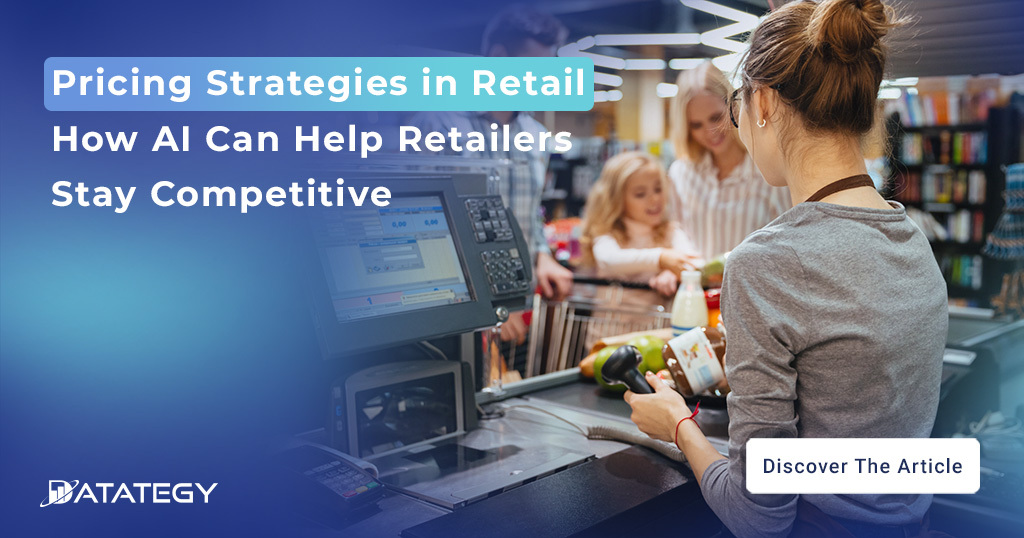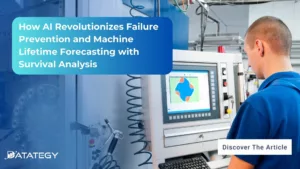Transform Defense Logs & Rapport into Situational Awareness with AI...
Read MoreOne of the most important factors in establishing a successful retail business is pricing. The difficult issue of striking the correct balance between affordability and profitability is one that merchants must constantly manage. Pricing strategies are now more complicated than ever because of the growth of e-commerce and rising competition. Fortunately, artificial intelligence (AI) can assist merchants in maintaining their competitiveness and improving their pricing tactics.

AI algorithms can analyze vast amounts of data, including customer behavior, competitor pricing, inventory levels, and market trends, to provide retailers with insights and recommendations for pricing. In this article, we will explore how AI can help retailers stay competitive in the ever-changing landscape of retail pricing.
COVID-19: Retail-Accelerated AI
The COVID-19 epidemic has had a significant influence on the retail sector and has significantly sped up the adoption of artificial intelligence (AI) in the sector. With customers increasingly turning to e-commerce in the face of lockdowns and social isolation measures, the move toward online purchasing that started before the outbreak has been further accelerated. As a result, merchants are now under pressure to swiftly modify their business practices to satisfy customers’ shifting needs, and AI has become a crucial instrument in this process.
According to a recent survey by Salesforce, 71% of retail executives believe that the pandemic has accelerated their company’s digital transformation by an average of three years. This has led to a surge in investment in AI technologies, as retailers look to improve their e-commerce operations, personalize shopping experiences, and better manage their inventory.
Another survey by McKinsey & Company found that 72% of retailers have increased their investment in AI since the start of the pandemic, with a focus on areas such as chatbots and virtual assistants, predictive analytics, and automated supply chain management. These investments have already begun to pay off, with retail companies reporting improved customer satisfaction, increased sales, and reduced operational costs as a result of their AI implementation.
What price optimization means ?
Setting the best possible price for a good or service in order to maximize profits is called price optimization. Finding the right balance between pricing a product high enough to maximize profits and low enough to draw customers and maintain market competitiveness is the aim of price optimization.
To find the best price for a product, one must analyze a number of variables, including manufacturing costs, customer demand, competitor pricing, and market trends. With the ability to analyze massive volumes of data and uncover patterns and trends that may be utilized to improve pricing, advanced analytics tools, and techniques, such as machine learning and data analysis, are frequently employed in this process.
Price optimization is a continuous process, though, because customer tastes and market conditions can change over time. In order to stay competitive, companies must constantly review and modify their pricing strategy.
Methods and techniques that retailers can use to leverage AI and improve their pricing strategies
By leveraging AI, retailers can analyze vast amounts of data and gain insights into consumer behavior and market trends that were previously impossible to obtain:
1- Dynamic Pricing
Dynamic pricing is one of the most often used uses of AI in pricing methods. Dynamic pricing entails altering prices in real time in response to a variety of variables, including competition, demand, and even weather patterns. Retailers can always determine the best pricing for their items by employing AI algorithms to examine data from numerous sources.
For example, Amazon uses dynamic pricing to adjust prices on its products several times a day based on factors such as competitor pricing, sales volume, and demand. This allows them to remain competitive while maximizing profits.
2- Predictive Analytics
Predictive analytics is another effective way that AI is being used in pricing tactics. Retailers may use machine learning algorithms to evaluate previous data to forecast future trends and pinpoint which goods are most likely to be well-liked by customers. As a result, shops are able to change pricing in advance and guarantee that the correct items are offered at the right prices.
For example, Walmart uses predictive analytics to analyze sales data and predict which products will be popular during certain seasons. They use this data to adjust prices in advance and ensure that they have enough inventory to meet demand.
3- Sentiment Analysis
Using AI, sentiment analysis examines consumer feedback and reviews to ascertain their attitudes regarding a good or service. Retailers may increase sales and consumer pleasure by assessing these attitudes and adjusting prices accordingly.
For example, if a particular product has consistently positive reviews, the retailer can adjust the price upwards to reflect the product’s perceived value. Conversely, if a product has negative reviews, the retailer can adjust the price downwards to make it more appealing to customers.
4- Markdown Optimization
Markdown optimization is the process of utilizing AI to decide when and how many markdowns are best for a certain product. Retailers can alter markdowns to increase sales and profit by examining past sales data and rival pricing.
For example, a retailer might use AI to analyze sales data from previous years to determine the best time to offer a discount on a particular product. They might also use AI to monitor competitor pricing to ensure that their markdowns remain competitive.
5- Product Bundling
Offering many products together at a discount is known as product bundling. Retailers may group items in a way that is most appealing to customers and increases profitability by using AI to assess client purchase history and preferences.
For example, a retailer might use AI to analyze customer purchase history to determine which products are frequently purchased together. They might then bundle these products together and offer them at a discounted price, increasing sales and customer satisfaction.
6- Competitive Intelligence
AI may be used to study the pricing practices of competing companies and modify prices accordingly. Retailers may stay competitive and preserve their market position by continuously analyzing competition prices. They are able to preserve consumer loyalty while staying ahead of the competition thanks to this.
The Benefits of AI in Pricing Strategies
1- Improved Accuracy
Improved accuracy is one of the main advantages of employing AI in pricing methods. Retailers may forecast customer behavior and market trends more accurately by employing machine learning algorithms to evaluate data. This enables companies to optimize earnings by establishing pricing that is more likely to be accepted by customers.

2- Real-Time Pricing Adjustments
Making real-time price modifications is a benefit of implementing AI in pricing methods. Retailers may instantly modify pricing to stay competitive and increase revenues by real-time evaluating data from numerous sources.

3- Personalization
According to a client’s browsing and purchase history, AI may also be used to tailor pricing for that specific consumer. Retailers may enhance the customer experience and increase sales by providing individualized clients with tailored prices and incentives.

Build your own price prediction software for retail
Among AI platforms, papAI platform helps retailers gain valuable insights into customer behavior, preferences, and habits, which can be used to adapt pricing strategy by integrating AI Retailers can increase accuracy, make real-time pricing adjustments, customize prices, boost efficiency, and raise consumer happiness by integrating AI into their pricing strategy.
If you are interested in learning more about how papAI can optimize your pricing, we invite you to book a demo and see the platform in action. Our team of experts will provide you with a personalized demo and answer any questions you may have. Take advantage of this opportunity to learn more about the benefits of AI and how it can help you to achieve your business goals.
Interested in discovering papAI ?
Our commercial team is at your disposal for any question.
Why AIOps Is Key to Cyber Threat Detection in Defense?
Why AIOps Is Key to Cyber Threat Detection in Defense?...
Read MoreHow AI Transforms Predictive Maintenance in Defense Equipment
How AI Transforms Predictive Maintenance in Defense Equipment In a...
Read MoreHow to Scale AI Without Breaking Your Infrastructure in 2025
How to Scale AI Without Breaking Your Infrastructure in 2025...
Read More


